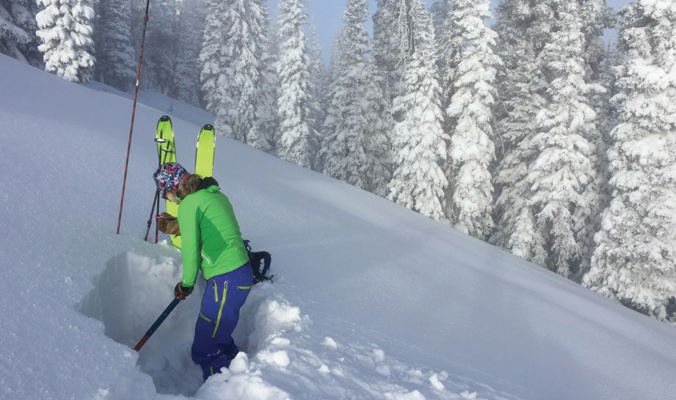If you’ve taken an avalanche class recently, you may have heard the quote, “The world of snow and avalanches is a wicked learning environment.” When you’re out in the snow-covered hills, you don’t get hourly or daily feedback on whether or not you’re making good decisions. A day without incidents is always good, but it provides no benchmark for both good and bad decisions. And this cycle can be compounded: when we’re overconfident, we might skip steps when planning or traveling in the mountains. This is often when accidents happen.
Even the most seasoned bc traveler can use a decision-making guide to keep analysis of terrain and group communication a top priority. Checklists provide a systematic approach in avalanche terrain and can help beginners and longtime tourers alike sort information to facilitate better decisions. Here are a few reasons to use a checklist to facilitate decisions.

Carpenter works through her daily checklist. [Photo] Courtesy American Avalanche Insitute
A checklist provides a daily system
Some days in the backcountry go smoothly. Some don’t. If we use the same system day in and day out, we are less likely to skip a step. In The Checklist Manifesto by Atul Gawande—a guide to dealing with life’s complex situations—he writes, “Discipline is hard—harder than trustworthiness and skill and perhaps even than selflessness. We are by nature flawed and inconstant creatures.” With this in mind, a checklist is a great way to ensure a basic level of discipline on any day, no matter how temping the powder may be.
A checklist facilitates easier communication
Have you ever been the least experienced person in the group and afraid to speak up? If this is ever the case, having a systematic approach to decision making that’s written down and can fit in your pocket can be empowering in tough situations and make communication with other group members easier. If you agree as a team that you’re going to use the checklist before you head out, then you have a framework for teamwork and communication as situations arise.
A checklist makes decisions more objective
Pre-trip planning is vital. Each day, you should identify terrain that is open, closed and on standby. It’s a lot easier to stick to the plan if this is done before walking out the door in the morning than if it’s done while you’re in the field. Powder fever is real, and if you’ve eliminated certain terrain before leaving the house, it’s easier to stick to appropriate terrain on tour, no matter what other groups are doing around you.
“A checklist cannot fly a plane,” Gawande writes. “Instead, they provide reminders of only the most critical and important steps—the ones that even the highly skilled professional using them could miss.”
How to start your checklist
Drafting a checklist that suits your needs can take years, but start with a simple concept. Break your day into categories. Start with a pre-trip plan—this happens inside in your slippers, before you walk out the door. Then move on to your in-the-field plan—what to do when approaching avalanche terrain and what questions should you ask every time? What’s going to kill you first? Finally, do a post-trip plan—this is an opportunity to learn from your day. Take the time to ask these questions every single time you’re out: Did we make good decisions? Did anything surprise us? What am I worried about for future tours? What should I share with the forecast center? The goal of a checklist is not to make a 20-page document, it’s to prioritize the steps that need to happen every single day.
Bottom Line: Checklists facilitate better procedures. They drive us to consider the important pieces of the puzzle each time we’re out. Dan Boorman, an expert in building checklists at Boeing reaffirms this: “[Checklists] can make priorities clearer and prompt people to function better as a team. By themselves, however, checklists cannot make anyone follow them.” So it’s up to you to set that standard for your friends and group members before venturing onto the skintrack.
—
Sarah Carpenter is the co-owner of the American Avalanche Institute and an AMGA-certified ski guide. Her first job out of college was ski patrolling at Bridger Bowl, Mont., and she’s been working in the snow and avalanche industry ever since as a patroller, ski guide and avalanche educator.











Related posts:
Mountain Account: A third-party rescue in Utah’s Wasatch Mountains
Mountain Skills: Get the Most Out of the Uphill
Fine tuned and dialed in: Off-season prep for the upcoming winter
The Skills Guide: Four steps for Blissful Ascents